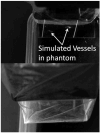Peripherally inserted central catheter placement using the Sonic Flashlight
- PMID: 19699661
- PMCID: PMC2760099
- DOI: 10.1016/j.jvir.2009.07.002
Peripherally inserted central catheter placement using the Sonic Flashlight
Abstract
The Sonic Flashlight is an ultrasound (US) device that projects real-time US images into patients with use of a semireflective/transparent mirror. The present study evaluated the feasibility of use of the Sonic Flashlight for clinical peripherally inserted central catheter placements, originally with the mirror located inside a sterile cover (n = 15), then with the mirror outside (n = 11). Successful access was obtained in all cases. Results show that this new design improved visibility, as judged subjectively firsthand and in photographs. The study demonstrated the feasibility of the Sonic Flashlight and the new design to help assure sterility without degrading visibility, allowing further clinical trials involving physicians and nurses.
Figures




Similar articles
-
Peripherally inserted central catheter placement with the sonic flashlight: initial clinical trial by nurses.J Ultrasound Med. 2009 May;28(5):651-6. doi: 10.7863/jum.2009.28.5.651. J Ultrasound Med. 2009. PMID: 19389904 Free PMC article. Clinical Trial.
-
Vascular access: comparison of US guidance with the sonic flashlight and conventional US in phantoms.Radiology. 2006 Dec;241(3):771-9. doi: 10.1148/radiol.2413051595. Radiology. 2006. PMID: 17114625
-
A novel technique of axillary vein puncture involving peripherally inserted central venous catheters for a small basilic vein.J Vasc Access. 2018 May;19(3):311-315. doi: 10.1177/1129729818757974. Epub 2018 Mar 29. J Vasc Access. 2018. PMID: 29592529
-
Peripherally inserted central catheter-related thrombosis rate in modern vascular access era-when insertion technique matters: A systematic review and meta-analysis.J Vasc Access. 2020 Jan;21(1):45-54. doi: 10.1177/1129729819852203. Epub 2019 Jun 10. J Vasc Access. 2020. PMID: 31177939
-
Meta-analysis of intracavitary electrocardiogram guidance for peripherally inserted central catheter placement.J Vasc Access. 2019 Nov;20(6):577-582. doi: 10.1177/1129729819826028. Epub 2019 Mar 6. J Vasc Access. 2019. PMID: 30838913
Cited by
-
Visualizing 3D objects from 2D cross sectional images displayed in-situ versus ex-situ.J Exp Psychol Appl. 2010 Mar;16(1):45-59. doi: 10.1037/a0018373. J Exp Psychol Appl. 2010. PMID: 20350043 Free PMC article.
-
The disembodied eye: consequences of displacing perception from action.Vision Res. 2010 Dec;50(24):2618-26. doi: 10.1016/j.visres.2010.08.025. Epub 2010 Aug 27. Vision Res. 2010. PMID: 20801143 Free PMC article. Review.
References
-
- Keyes LE, Frazee BW, Snoey ER, Simon BC, Christy D. Ultrasound-guided brachial and basilic vein cannulation in emergency department patients with difficult intravenous access. Ann Emerg Med. 1999;34(6):711–714. - PubMed
-
- Costantino TG, Fojtik JP. Success Rate of Peripheral IV Catheter Insertion by Emergency Physicians Using Ultrasound Guidance. Acad Emerg Med. 2003:487.
-
- Chinnock BF, Thornton S, Hendey GW. Nurse-performed Ultrasound-guided Upper Extremity Venous Cannulation in Emergency Department Patients with Difficult Venous Access. Acad Emerg Med. 2005:35.
-
- Fuchs H, State A, Pisano ED, et al. Towards performing ultrasound-guided needle biopsies from within a head-mounted display. Presented at Visualization in Biomedical Computing; September 22-25, 1996; Hamburg, Germany.
-
- Rosenthal MS, Lee J, Hirota G, et al. Augmented reality guidance for needle biopsies: An initial randomized, controlled trial in phantoms. Med Image Anal. 2002;6:313–320. - PubMed
Publication types
MeSH terms
Grants and funding
LinkOut - more resources
Full Text Sources

